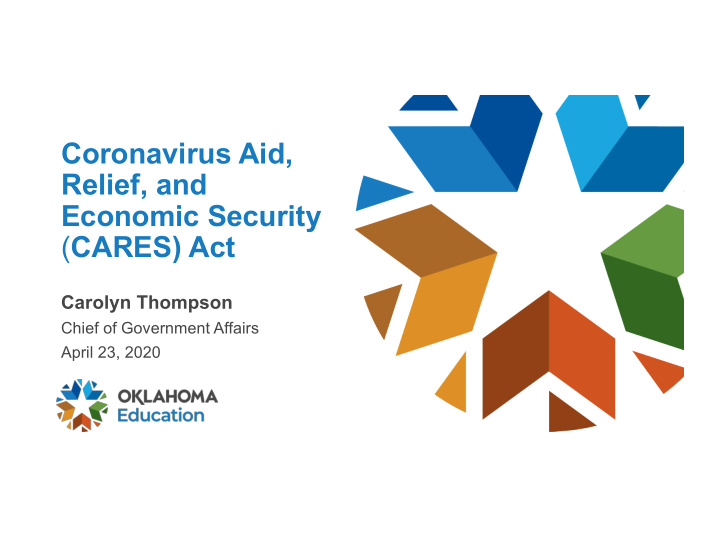



Coronavirus Aid, Relief, and Economic Security ( CARES) Act Carolyn Thompson Chief of Government Affairs April 23, 2020
What is the CARES Act? • Single largest stimulus package in U.S. history. • Became law March 27, 2020. • Appropriates roughly $2 trillion in coronavirus relief funding for individuals, businesses, corporations, state governments, public health and education. • Grants significant flexibility in use of funds for responding to emerging needs. 2 CARES Act
Education Relief Funding ($30.75b total) Higher Education Governor’s Emergency Relief Emergency Education Fund, $13.95b Relief Fund, $2.95b 46.3% 9.8% Elementary and Secondary School Emergency Relief Fund, $13.23b 43.9% 3 CARES Act
Elementary and Secondary School Emergency Relief Fund (ESSERF) • Oklahoma anticipates receiving just under $161 million in K- 12 funding. • 90% of these funds are required to be distributed to LEAs (i.e., districts). • 0.5% of total funds may be reserved for administrative costs. • 10% of funds may be used for “emergency needs” as determined by OSDE and may be issued as grants. 4 CARES Act
Elementary and Secondary School Emergency Relief Fund (ESSERF) • LEAs will receive funds proportionally equal to the amount of Title 1 funding received in the most recent allocation. • Allowable uses: 1. any activity authorized by ESEA (IDEA, McKinney-Vento, etc.); 2. coordinate efforts with departments of health; 3. resources for school leaders to address individual student needs; 4. delivery of services to at-risk and minority students; 5. procedures to improve school preparedness and response; 6. training on sanitation/minimizing the spread; 5 CARES Act
Elementary and Secondary School Emergency Relief Fund (ESSERF) 7. purchase cleaning supplies; 8. plan for/coordinate services during long-term closures (providing meals, online learning, IDEA services, etc.); 9. purchase educational technology (including hardware, software and connectivity) to conduct online learning; 10.provide mental health services and supports; 11.summer learning activities, supplemental after-school programs; 12.other activities necessary to maintain the operation and continuity of services and continuing to employ existing staff. 6 Presentation Title
Elementary and Secondary School Emergency Relief Fund (ESSERF) • Funds can benefit all students and school sites of a district, not only Title I schools. • USDE must make SEA application for funds available within 30 days of passage (i.e., April 27). • Funds flow through the State Education Agency (i.e., OSDE). OSDE will allocate these to districts as quickly as possible. • Funds available for use through September 30, 2021. 7 Presentation Title
Application and Assurances • Both the SEA and LEA will have to apply for the funds and complete certain assurances. • Each LEA receiving monies through the CARES Act “shall to the greatest extent practicable, continue to pay its employees and contractors during the period of any disruptions or closures related to coronavirus . ” 8 CARES Act
Governor’s Emergency Education Relief Fund (GEER) • Oklahoma anticipates receiving just under $40 million . • The Governor may use funds to support any of the following: • LEAs OSDE deems most significantly impacted; • Higher education institutions the Governor deems most impacted; and/or • Any other education-related entity the Governor deems essential for carrying out emergency educational services. 9 CARES Act
Maintenance of Effort (MOE) • In order for Oklahoma to qualify for CARES Act education funding, the state must assure that it will: • Maintain support for education in the next two fiscal years at a level greater than or equal to the average of the prior three fiscal years. • May be waived for states that “have experienced a precipitous decline in financial resources.” 10 CARES Act
Emergency Education Waivers • USDE authority for waivers of assessment, accountability and reporting requirements. • Secretary to recommend to Congress any additional waivers needed, including IDEA, the Rehabilitation Act, Perkins and ESSA. • Waivers may never request an exception from civil rights law and expire after 2019-20 school year. 11 CARES Act
Funding Flexibility Waivers (USDE granted April 7) • 15% carryover limitation for FY 19 Title I, Part A • Extend the period of availability for expiring funds (FY 18) until September 30, 2021 • Needs assessment aligns to use of funds • Title IV, Part A content-area spending requirements • Well-rounded education, safe and health schools, use of technology, including 15% spending cap on infrastructure • Definition of “professional development” 12 CARES Act
Future Emergency Relief? • Congress is currently deliberating on a fourth supplementary coronavirus relief package. • Additional E-Rate funds may be included in this package (funds to schools and libraries for technology infrastructure like broadband). 13 CARES Act
Recommend
More recommend